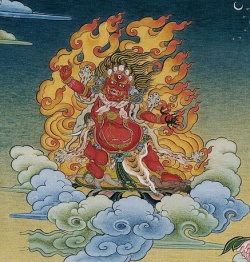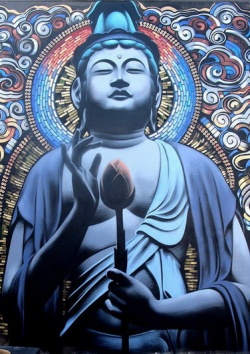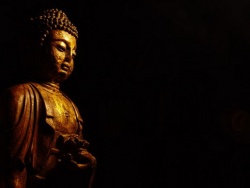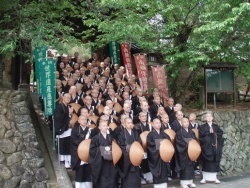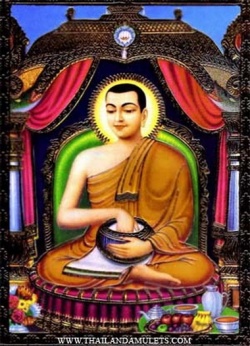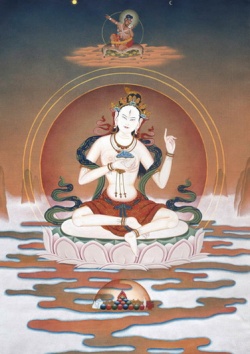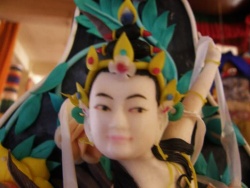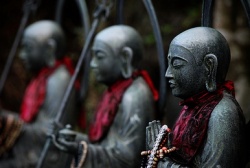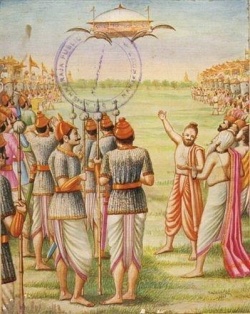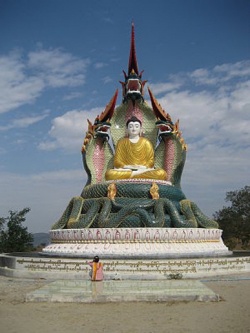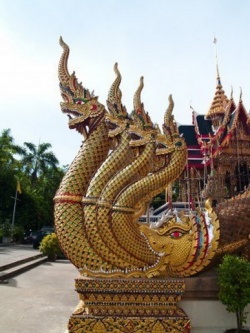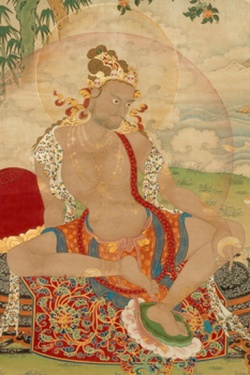The Sutra on Limitless Meanings
The Sutra on Limitless Meanings
Introduction
The Sutra on Limitless Meanings (C. Wu-Liang-I Ching, J. Muryogi Kyo) was translated into Chinese by Dharma-Jatayasas in 480 CE. By comparison Kumarajiva translated The Lotus Sutra around 406 CE, but an earlier surviving translation was made of it was made by Dharma-Raksa as early as 286 CE.
In The Sutra on Limitless Meanings, the Buddha sums up his first 40 years of teaching the Dharma. He explains that there has always been but one spiritual reality (Dharma), but it has been explained in limitless ways to adapt to the different prejudices, natures, desires, and capacities of the various spiritual seekers. The Dharma has always been one and the same, beyond prejudice, beyond aspects, inconceivable and inexpressible, but the different audiences have given limitless different meanings to it, which has been a reflection of their prejudices, desires, and capacities. This of course is still true today. The Dharma, the spiritual reality, is always the same, but each of us give it new meaning through our unique lives and our different paths to enlightenment.
This relatively short Sutra is divided into three chapters.
- The Practice of Virtue
- The Teaching of The Dharma
- The Ten Merits and Virtues
The Sutra of Limitless Meanings serves as a preface to The Lotus Sutra. It sums up the provisional teachings of the Dharma in preparation for the quintessential teaching. As the introductory chapter of The Lotus Sutra relates, having completed the summa of the provisional teachings and the ten stages (S. Bhumis) of the Bodhisattva path, the Buddha enters into the deep Samadhi of Limitless Meanings. Having reached the perfection of the provisional teaching, there will be the revelation of the ultimate teaching, which is The Lotus Sutra.
The Lotus Sutra goes beyond the provisional teachings and reveals the ultimate will and intent of the Buddha, first of the historical Buddha (the Buddha as revealed to the world) and then of the eternal embodiment of enlightenment.
On the Title of the Sutra The title of The Sutra of Limitless Meanings expresses the Three Truths.
- The Buddha explained the empty nature of the Dharma - that ultimately it does not have a specific nature or form, that it is neither great nor small, that is neither visible nor invisible, etc.
- The Buddha explains the temporary nature of dharmas (the aspects of spiritual reality) and how they are born, remain a while, are changed and then perish. These are the ‘four aspects’ of transience.
- Where these two intersect, there is the mean. In this Sutra it is called the ‘meaning’.
- It is where Life & Death meets up with Nirvana.
- It is where emotional troubles meet up with awakening.
- It is where living beings meet up with the Buddha.
- It is where the Dharma is taught, where it is faithfully received and where enlightenment is attained.
These Three Truths are expressed in the Sutra’s title:
- Without, Nonexistence (C. Wu, J. Mu) = Emptiness
- Limit, Measure (C. Liang, J. Ryo) = That Which is Temporary
- Meaning, Significance (C. I, J. Gi) = The Mean
On the meaning of the word Sutra (C.Ching, J. Kyo) The Sutra is literally the very word of the Buddha. The Sutra is the Buddha's eternal life in what is known as the Spiritual Body or Spiritual Life (S. Dharmakaya). In practicing the Sutra (reading it, reciting it, understanding it, worshipping it, propagating it, living up to it, etc) one brings it to life and attains its wisdom and virtues (the Body of Reward, S. Sambhogakaya) and becomes the Buddha teaching the Dharma to enlighten others (the Body of Response or Manifestation, S. Nirmanakaya).
The Sutra is the Sutra, whether it is The Lotus Sutra, The Sutra of Limitless Meanings or any of the other manifestations of the word of the Buddha. There really is only one Sutra in the same sense that there is only one Dharma.
Chapter One - The Practice of Virtue
Ananda opens up the Sutra with the same expression of faith that opens virtually all the sutras: 'Like this I have heard'.
He describes the setting. The Buddha is at Vulture's Peak (Mt. Gridhakuta) in Rajagriha ('The Royal Residence', the capitol of Magadha) with a great assembly of Bodhisattvas, disciples and believers. The assembly is presented, the names and the virtues of the Bodhisattvas and those of the Two Vehicles are described in some detail, and they all offer worship to the Buddha.
Speaking for the whole assembly, the Bodhisattva Great Adornment describes, praises and worships the Buddha, including:
1. His Spiritual Body or Spiritual Life (S. Dharmakaya), which is beyond all aspects and descriptions. This Spiritual Body is described in a series of negations:
- "His body is neither exists nor is without existence,
- It is neither a cause nor a condition, neither a self nor an other,
- It is either linear nor round, neither long nor short,
- Neither appearing nor disappearing, neither born nor extinguished,
- Neither inherent nor created, neither natural nor artificial,
- Neither seated nor lying, neither walking nor standing,
- Neither stirring nor revolving, neither calm nor still,
- Neither advancing nor retreating, neither safe or in peril,
- Neither right nor wrong, neither attained nor lost,
- Neither here nor there, neither coming nor going,
- Neither blue nor yellow, neither red nor white,
- Not crimson, not purple, nor any other color..."
2. His Body of Reward or Manifold Virtues and Wisdom (S. Sambhogakaya)
- "It is born of morality, mental concentration, spiritual insight, liberated understanding, as well as knowledge & vision,
- It is inspired from Samadhi, the six penetrations & the facets of spiritual awakening,
- It arises from kindness & compassion, the ten spiritual powers & the four fourfold fearlessness, and
- It appears because of the good karmic deeds of living beings..."
3. His Body that Appears Before Us (S. Nirmanakaya) in its ideal human form with its 32 signs and 80 excellences, teaching the Dharma to all living beings .
- "Revealing himself to be over ten feet tall, clad in sparkling gold and purple,
- He is well proportioned, and he radiates a brilliant aura.
- With hair curled like cresent moons, and a nape like sunlight,
- His curling hair is a deep indigo blue, with a fleshy protuberance on the crown.
- With eyes, pure like a clear mirror, blink straight up and down,
- His brow trails in deep indigo, and his mouth and cheeks are well formed.
- With lips and tongue pleasingly red like a scarlett blossom,
- His forty teeth are white like snowy agate.
- With a broad forehead and a high-bridged nose, his countenance is majestic.
- His chest is like that of a lion, with the sign of the swastika.
- His hands and feet are pliant, with the sign of the thousand spoked wheel.
- His armpits and palms are well rounded and have fine lines.
- His arms are long and graceful, and the fingers are straight and slender.
- His skin is smooth and delicate, and his hair curls to the right.
- His ankles and knees are well articulated, and his male organ is retracted like a stallion.
- His sinews, his collarbone and his thighs are all slim like a deer.
- His chest and back are radiant and without a blemish.
- He is unsullied by mud and untainted by dust.
- Like this, there are the thirty-two signs
- And the eighty kinds of excellence that are all plain to see..."
This is the threefold body or life of enlightenment.
The first chapter concludes with the Bodhisattva Great Adorment speaking for the entire audience in paying homage and worshipping this Buddha of the Three Great Virtues.
Chapter Two - The Teaching of the Dharma
In the second chapter, the Buddha tells the Bodhisattva Great Adornment that He will enter into Parinirvana before long, and that the Bodhisattvas should ask any questions they still have that will resolve any remaining doubts. Speaking for the Bodhisattvas, the Bodhisattva Great Adornment asks what doctrine they should practice to quickly attain perfect enlightenment. The Buddha speaks of it as being it the Doctrine of Limitless Meanings.
The Buddha explains the empty nature of the Dharma (the spiritual reality) - that ultimately it does not have a specific nature or form, that it is neither great nor small, that it is neither visible nor invisible, etc. People cling to it being this or that, but these attachments just return them to the impermanent realm of Life & Death (Samsara).
The Buddha then explains the temporary nature of dharmas (the aspects of spirituality) and how they are born, remain a while, are changed and then perish - the ‘four aspects’ of transience. The one Dharma is beyond aspects - it is without aspects, and yet it is neither with nor without aspects. Calmly abiding in this, there is realization of the true spiritual aspect of reality, which is understanding all the different aspects in the context of the one Dharma. In applying this principle to the teaching of the Dharma, there are the different teachings that respond to the different prejudices, natures, desires, and capacities of living beings. In this way the one Dharma is invested with its different meanings.
The Bodhisattva Great Adornment then asks the Buddha to explain the difference between this Sutra of Limitless Meanings and the teachings of the prior 40 years.
The Buddha responds by saying that when he first attained enlightenment in Gaya He could see with His enlightened eye that all things spiritual could not be immediately taught to living beings because of their various different kinds of prejudices and capacities, and so he taught the various provisional teachings. He could not yet teach the absolute reality.
He taught that the nature of the Dharma is like water in washing off the stains that are the emotional troubles of living beings. However, water may come from a ditch, a stream, a river, a lake or the ocean. There are different meanings to each of these, but they are all water, and they all wash off different kinds of stains.
Depending on the inclinations and the capacities of those that were being addressed, there were different meanings ascribed to the Dharma, and so there were the different levels of realization. The Buddha explained the progression of teachings that He made over His life, including the four truths, the twelve fold wheel of dependence on origination, the paramitas, etc. In all of these teachings, He always taught about “suffering, emptiness, impermanence and selflessness; and that which is neither absolute nor temporary, neither great nor small, fundamentally without birth - the one aspect without aspects. The aspect and nature of the Dharma is neither coming nor going, and yet there are the four aspects of transience by which all living beings are driven.”
Because of these meanings the Buddhas are able to respond with the single Sound of the Dharma through a host of different of voices. They are able to reveal the single Spiritual Body (S. Dharmakaya) through countless different incarnations. This is the very deep sphere of the spiritual realm that is only fathomed between the Buddhas and not known by the Bodhisattvas of the provisional teachings and those of the Two Vehicles.
Upon making this teaching, there were a variety of spiritual signs, such as the shaking of the earth, the raining down of blossoms, treasures, etc., and great realizations by the assembly.
Chapter Three - The Ten Merits and Virtues
In the third chapter, the Bodhisattva Great Adornment praises this teaching of the Dharma, and asks four questions:
- From what place does this Sutra come?
- To what place does this Sutra go?
- In what place does it remain?
- How does it have such inconceivable powers to produce its limitless merits & virtues?
The Buddha praises the questions and answers that the Sutra comes from the abode of the Buddhas, goes to all living beings that inspire the Bodhi mind, and remains in the place where all Bodhisattvas practice. Then the Buddha tells of the Sutra’s ten inconceivable powers to produce its limitless merits and virtues:
1. The First Virtue:
It makes those that have not inspired the mind inspire the mind.
It makes the merciless inspire kindness & benevolence
It makes those that take life inspire greatness of compassion
It makes the jealous inspire acceptance and sympathetic joy for others
It makes those with a mind of craving and attachment inspire equanimity
It makes the stingy and greedy inspire generosity and charity
It makes the arrogant and conceited inspire the mind that embraces the precepts
It makes the hateful and angry inspire patience and endurance
It makes the lazy and negligent inspire diligence
It makes the distracted and confused inspire mental (meditative) concentration
It makes the foolish and deluded inspire spiritual wisdom and insight
It makes those not interested in saving others save others
It makes those practicing the ten evils practice the ten virtues
It makes those who wish for the conditional aspire to that which is unconditional
It makes those that regress in spiritual progress stop regressing
It makes those with afflictions inspire non-affliction
It makes those with emotional distress inspire its extinction
2. The Second Virtue:
If one hears this Sutra but once, or even a single phrase of it, and penetrates and realizes its limitless meanings, from this single seed hundreds of other will grow, and from these hundreds more, and so on until there will be countless good spiritual roots. Therefore it has the name ‘Limitless Meanings’.
3. The Third Virtue:
Having heard the Sutra and penetrated its limitless meanings, one will become fearless in the realm of mortality (Life & Death) and, with bravery and compassion for others, one will carry the treasure of enlightenment on one’s shoulders, which is carrying living beings on one’s shoulders all the way out of this realm of mortality. One will be like the captain of a ferry boat, carrying others across to the other shore of Nirvana but remaining tied to the shore of ignorance, old age, sickness and death (Samsara) because of the 108 kinds of emotional distress. This is practicing the Sutra as it is preached.
4. The Fourth Virtue:
When one hears the Sutra even once, or even part of it, and attains the bravery and compassion as described above, even though one is not fully enlightened, one will have joined the true ranks of the Bodhisattvas, and the Buddhas will teach and guide one. One will hear the Buddhas, obey them, and interpret the Dharma for others as called for. It is like a young prince who not yet able to manage the royal business but is revered by the King, the Queen and the people. The King (the Buddha) and the Queen (the Sutra) came together and the Prince (the Bodhisattva) is their offspring. The King and Queen always stay and converse with him with deep love and affection because he is their child. The Bodhisattvas are also like this - they hear the Sutra once, twice, innumerable times and they come to shake the whole spiritual realm of the world even though they do not yet realize the ultimate truth. They are admired by all living beings even though they cannot yet teach the Dharma with the noble voice that is like a roll of thunder. They come to deeply know the secrets of the Buddhas and will always be protected by them. They will always be enveloped in affection because they are beginners in learning.
5. The Fifth Virtue:
Whether it is during the Buddha’s lifetime or after His extinction, these Bodhisattvas will accept, embrace, read, recite and copy the Sutra. They will be able to reveal the path of enlightenment to living beings even though they are not yet able to free themselves from the fetters of the emotional distress of ordinary people. They can extend a single day into a hundred eons and reduce a hundred eons into a single day and fill living beings with joy and faith. They are like the son of the Dragon King who even seven days after his birth can cause the rain to start or stop.
6. The Sixth Virtue:
Whether it is during the Buddha’s lifetime or after His extinction, these Bodhisattvas will accept, embrace, read, recite and copy the Sutra. Although they are not free from emotional distress, they will teach the Dharma to living beings, free them from all the sufferings of mortality (Life & Death) and emotional distress, cultivate the practice and attain the path and fruits of enlightenment. They will be the peers of the Buddhas. It is like a young prince that manages the royal affairs when the King travels or suddenly becomes ill, performing all the duties properly and efficiently. Like this, the Bodhisattvas will do the work of the Buddha even if they cannot yet abide in the beginning stages of steadfastness. If living beings hear them and cultivate their practice with a single mind, they will extinguish emotional distress and attain the path and fruit enlightenment.
7. The Seventh Virtue:
Whether it is during the Buddha’s lifetime or after His extinction, these Bodhisattvas will hear, rejoice and believe in this Sutra, and they will accept, embrace, read, recite, understand and teach it, and practice it as they teach it. They will inspire the Bodhi mind and arouse good spiritual roots. With greatness of compassion they will have the will to save all living beings that are suffering and distressed. Although they do not cultivate the practice of the six paramitas, the six paramitas will spontaneously appear before them. In this very life they will attain the endurance in the Dharma that is without birth. Life & Death and emotional distress will instantly be destroyed and they will rise up to the seventh stage of the Bodhisattvas. It is like the strong and persevering man that went out and slayed the enemy of the King. The King rejoiced and gave him half of his kingdom. Those that keep this Sutra are like this. The most strong and persevering practitioners will attain the treasure of the six paramitas without seeking to attain it for themselves. The enemy that is mortality (Life & Death - Samsara) will be destroyed naturally, endurance in that which is without birth will be realized, and half of the Buddha’s treasure will be secured.
8. The Eighth Virtue:
Whether it is during the Buddha’s lifetime or after His extinction, these Bodhisattvas will see others who have received the Sutra, make them reverently believe in it as if it were the very life of the Buddha, and make them wish to accept, embrace, read, recite, copy and worship it. Firmly keeping the precepts with endurance and practicing with generosity, they will deeply inspire great kindness and compassion. They will spread the teaching of this supreme great vehicle that is The Sutra of Limitless Meanings. With various ways and means they will show this Sutra to those that have never recognized the existence of sin and blessedness and compel them to believe in it. The spiritual power of Sutra will stir them to believe and will turn them around. Already having faith, with valor and diligence they will attain the spiritual powers that are the virtues of the Sutra, and so they will attain the path and fruits of enlightenment. They will attain the endurance in the Dharma that is without birth, they will attain the highest stages of the Bodhisattvas, they will become the followers of the Buddha and they will quickly bring living beings to the Pure Land of the Buddha. They will surely attain enlightenment before long.
9. The Ninth Virtue:
Whether it is during the Buddha’s lifetime or after His extinction, upon acquiring this Sutra and rejoicing in it, they will jump for joy at attaining that never before had. They will accept it, embrace it, read it, recite it, copy it, offer service to it, spread it to others, understand its meaning and teach it. They will instantaneously extinguish the sins and heavy obstacles from past lives and become pure. They will acquire great eloquence and attain a sequence of adornments including the paramitas, the samadhis, the Surangama Samadhi, entry into the great door of dharanis and, with the power of diligence, strive to quickly attain the highest stage of the Bodhisattvas. They will be able to skillfully spread their spiritual emanations everywhere in the lands of the ten directions and rescue all living beings in the twenty-five states of existence (the six spiritual realms of Life & Death), ultimately liberating them from suffering. This Sutra has spiritual powers such as these.
10. The Tenth Virtue:
Whether it is during the Buddha’s lifetime or after His extinction, upon acquiring this Sutra they will rejoice in it with a rare mind. Having already accepted it, embraced it, read it, recited it, copied it, offered service to it, understood it and taught it, and practiced it as taught, they will encourage both those at home (laity) and those who have left home (ordained) to accept, embrace, read, recite, copy, offer service, understand and teach it, and practice it as taught. They will make others cultivate the practice through this Sutra’s spiritual power. Because of the power of their mercy all will attain the path and fruits of enlightenment. In this life they will quickly attain the limitless doors of dharanis. From the ordinary person’s very first stage of inspiration they will be able to realize countless great vows and deeply inspire and rescue all living beings. With great compassion they will be able to root up a host of sufferings, gather many good spiritual roots and abundantly benefit all. They will explain the great enrichment of the Dharma that nourishes all those that are withered. They will give out the medicine of the Dharma and offer peace and contentment to all. Gradually elevating their view until they abide in the stage that is the Cloud of the Dharma, their blessings will enrich all everywhere, granting mercy to living beings and making them enter into the steps of the path. Before long they will attain the supreme universal enlightenment.
The great vehicle that is The Sutra of Limitless Meanings has an ultimately great spiritual power that is unsurpassed in esteem. It is able to make ordinary people attain the noble fruit of enlightenment and forever be free of the mortality of Life & Death. Therefore it is called The Sutra of Limitless Meanings.
Led by the Bodhisattva Great Adornment, the Bodhisattvas praised this great vehicle profusely and there were a host of spiritual signs; the world shook six ways and four kinds of blossoms rained down from heaven.
The Buddha encouraged them further to practice the Sutra and the Bodhisattvas worshipped the Buddha and vowed to do so. The Buddha praised them for doing so. The Bodhisattvas took possession of the Sutra and withdrew.
